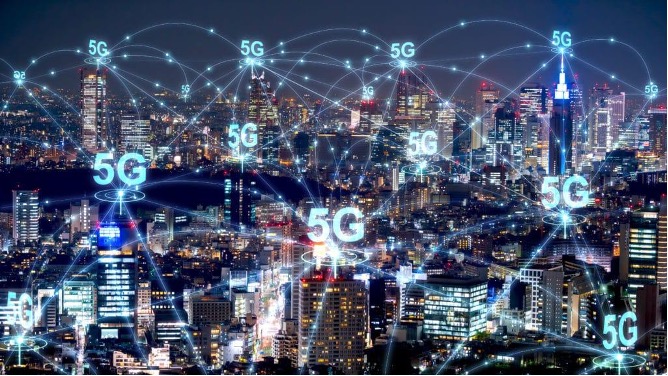Digital signage is evolving rapidly. As one of the fastest-growing solutions for communication, the future of digital signage is bright (beyond just the screen). Digital signage software is capable of producing more content than ever, and hardware options are advancing. Round nearly every corner, you will now find some form of digital signage.
But what can we expect to see in the future of digital signage? In this blog, we explore five advancements that have changed the game for future signage.
Smart Cities and Campuses
Life moves fast, and bustling areas need efficiency. As a result, the future will see an increase in smart cities and campuses. Though no one wants to see robots take over the world, digital solutions can streamline operations, reduce human resources, and increase resident quality of life.
A smart city/campus can use digital wayfinding to help users navigate an area, digital information hubs to answer FAQs, and digital posters to reliably advertise products or services. These signage solutions can be updated easily, as well as scheduled.
Smart technology can improve a city in areas such as transport, healthcare, sustainability, and safety. For example, digital solutions can improve the daily commute by presenting live traffic data, alternative routes, or parking space information. Additionally, installing IoT (Internet of Things) sensors on existing infrastructure can ensure problems get fixed before they cause delays.
People increasingly want rapid communication and innovation. Therefore, the future of digital signage can expect a growth in smart cities and campuses to keep up with change. As technology becomes cheaper and readily available, almost any campus or city could utilise digital signage solutions.

Touchless displays in the Future of Digital Signage
In the last decade, touchscreen digital signage has become a popular trend. Evidence suggests that switching from static posters to interactive solutions can increase ad sales by almost 1,200%. Yet, in light of the pandemic and fear of germs, there is a need for alternative interactive signage.
Consequently, the future of digital signage can expect to see an increase in touchless displays. These screens activate content via contactless triggers. Prompts include smoke sensors, proximity sensors, facial recognition, infrared touchless LED buttons, or voice recognition.
Following the pandemic, touchless digital signage will have its popularity questioned. Nevertheless, in a society that champions innovation and where brands want to stand out from competitors, partnered with a persisting hesitancy to touch public devices amongst customers, we can expect touchless displays to become a popular form of future signage.

5G Connectivity
5G connectivity is the new hot topic of conversation. Known as “the new generation of wireless technology”, 5G, the successor of 3G and 4G, promises unparalleled speeds and response times that have the potential to revolutionise digital signage.
To accentuate the difference 5G could make to future signage, 4G currently achieves an average speed of 45Mbps (megabits per second) in real-world (non-laboratory) conditions. 5G will achieve average speeds ten to twenty times faster, allowing a high-definition film to download in a minute.
Additionally, through greater use of the radio spectrum, 5G allows more devices to access mobile internet at one time. This capability benefits future signage; 4G connection can slow when multiple people are using the internet in the area at one time. Contrastingly, 5G maintains high speed, preserving content quality.
5G connectivity will enable businesses to present game-changing digital display content. We can expect to see an increase in augmented reality, high-definition video and graphics, a new range of widgets, live sensory technology, and immediate live data and maps.

The Future of Digital Signage Screen Quality
The success of digital signage relies on grabbing attention. Sharp screen quality does this. A few years ago, 4K was the next big thing, replacing 1080p as industry-standard digital display resolution. But technology never stops advancing, and 8K is no longer a dream for future signage.
In the 2000s, TV screens leapt into 1080p, offering a resolution of 1,920×1,080 pixels. 4K screens then doubled those numbers to 3,840×2,160 and quadrupled the number of pixels. As you can expect, 8K doubled those numbers again to a resolution of 7,680 by 4,320 with four times the number of pixels as 4K.
With this sharpness, the future of digital signage will be one of unparalleled screen quality, providing an enhanced experience for users. Importantly, videos and images will be high definition, and text easier to read, for example, on digital menu boards. On a larger scale, digital billboards will benefit from an increase in pixel resolution. These advances will increase the potential for sales and customer interaction.
8K displays are far from the norm; there is a huge price jump between 4K and 8K screens, and 8K content needs creating. Yet, with rising 5G connectivity and fast-moving innovation, we can expect 8K screens to become the new industry standard amongst big businesses in the next two to three years and smaller companies after.

Prices Will Fall, Popularity Will Rise
If historical trends in hardware pricing continue, future signage screen prices will fall. In 2010, 52% of Americans had seen a public digital video display in the past week. This figure across digital signage has undoubtedly grown tremendously in the last decade. With prices falling, we can expect digital signage to further rise in popularity.
Digital signage screens are a specialised technology, sharp and sustainable. While consumer-grade screens, like household TVs, are less expensive, commercial-grade displays can reliably show long hours of high-quality content. Moreover, the high brightness ratings of commercial-grade screens ensure content is visible even in direct sunlight.
In the past, the cost of a commercial grade screen has deterred businesses from using digital signage. Yet, as technology advances, digital signage screens will become affordable for most companies.






















